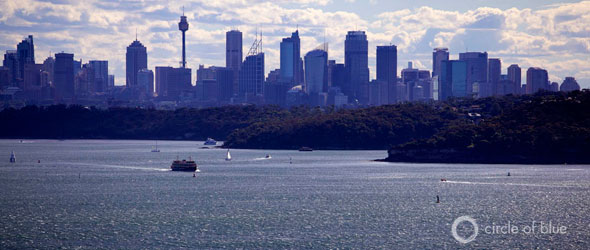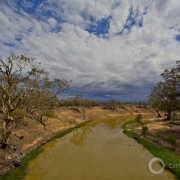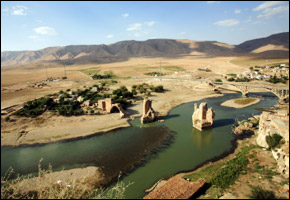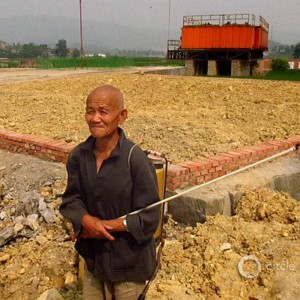To Drought-proof City’s Water Supply, Sydney Proposes a Second Set of Pipes
Australia’s largest urban economy wants to build a parallel water system to deliver non-potable supplies.

By Brett Walton
Circle of Blue
The City of Sydney, one of 38 political subdivisions in Australia’s largest metropolitan region, is in the final stage of preparing an ambitious master plan that seeks to refashion its water infrastructure to meet the constraints of a water-scarce future.
One of the oldest sections of Australia’s 224-year-old hub, the City – which includes the central business district and is home to 185,000 of the 4.6 million people in greater Sydney – envisions a second water-distribution network that would provide water for purposes other than drinking. This parallel system would tap into new sources like salty water, purified by waste heat from power plants, as well as existing sources, such as recycled wastewater and rainwater, which are typically flushed out to sea.
–Lord Mayor Clover Moore
City of Sydney
“For a major urban centre to have two networks — one delivering potable water and another delivering non-potable water — it would be ground breaking in Australia,” Monique Retamal wrote in an email to Circle of Blue. Retamal, a researcher at the Sydney-based Institute for Sustainable Futures, helped to develop the City’s water plan. “As far as I am aware, there are no other similar plans elsewhere in the world.”
The city council not only wants to adapt its obsolete infrastructure to a changing climate, said Bhakti Devi, the city’s manager for water strategy. Because cities worldwide will soon be confronting the same problems, the City also wants to be a pioneer for urban water solutions globally.
“We want to leverage our influence,” Devi told Circle of Blue. “We want to put the message out there that we need to re-think water infrastructure.”
Setting Broad Goals
In addition to the decentralized system, the plan incentivizes water efficiency in commercial and residential buildings and sets targets for reducing the amount of polluted water that flows into rivers and harbors after storms.
The water plan has four goals to be achieved by 2030:
- Reduce water use by 10 percent from a 2006 baseline.
- Reduce water use by 25 percent within buildings that are owned by the City of Sydney.
- Get at least 10 percent of supplies from local water capture — that is, recycled wastewater, rainwater, or energy-efficient desalination.
- Reduce the amount of suspended solids by 50 percent and the amount of nutrients by 15 percent in stormwater that is dumped into local waterways.
The City’s plan comes after a historic drought from 2003 to 2010, which saw Sydney’s main reservoir fall to just 33 percent of capacity and spurred the construction of a desalination plant that now gathers dust because rains have since refilled the reservoirs. The plan also comes after major reductions in water use over the past two decades.
Sydney Water Corporation (SWC), the regional supplier serving more than 4 million people, invested AUS$ 370 million to cut per-capita consumption by 35 percent from 1991 to 2011, winning the Stockholm Industry Water Award in 2006 for these efforts.
Nonetheless, on a dry continent with a steadily growing population, leaders are looking for still more ways to become resilient.
“It’s imperative the City’s water supply is sustainable, drought-proofed, and utilized to adapt to climate change,” according to the water plan’s forward, written by the City’s mayor and its chief development officer for energy and climate change.
The cost of the plan, which could run into the billions, ultimately depends on which projects are selected.
Data Driven
To develop its blueprint, the city council paired its own data on floor-space use with water consumption data from SWC to find out what sectors were using water and how much they were using. The city council — with technical help from two consultancies: the Institute for Sustainable Futures and GHD and P3IC — then added data on water-efficiency standards to develop benchmarks for each sector.
They found that water use is very different in the City of Sydney when compared to the rest of the metropolitan area.
–Bhakti Devi, manager for water strategy
City of Sydney
For instance, the commercial sector — restaurants, hotels, offices, and other such properties — consumed 42 percent of the water in the City, compared to just 10 percent in the larger metropolitan area. For residential properties in the City, apartments comprised a much bigger share (38 percent of consumption) than single-family homes (7.9 percent).
Using these data, the council can nudge the owners of apartments and office buildings to adopt water-wise practices, but it cannot push them: only the state government has the authority to set the standards used in building codes.
“New buildings have to have efficient elements, but that doesn’t apply to existing buildings,” said Devi, the City water manager. “All we can do is advocate for a mandate. In the City, we can provide incentives such as rebates and education programs.”
Practical Applications Already In Place
A building in Sydney’s business district, however, has already applied the new thinking. One Bligh Street, which opened in 2011, has been called by many the “greenest office building in Australia.”
In a process called “sewer mining,” One Bligh Street taps into Sydney’s sewer system to withdraw wastewater. A purification unit in the basement provides enough treated water to cover 100 percent of the building’s toilet use and 90 percent of the feed water for its cooling tower.
Several golf courses, parks, and office buildings in the Sydney metropolitan area mine the sewers in this way, and the process is a key component of the City’s water master plan.
In some cases, though, Australia’s largest city is playing catch-up. In 2007, the federal government set a national target of recycling 30 percent of collected wastewater. Adelaide, Brisbane, and Melbourne each recycle more than 20 percent, while greater metropolitan Sydney lags well behind at just 7 percent.
The City of Sydney, meanwhile, recycled 6 percent of its water in 2010, but the plan forecasts that more than half of water demand in 2030 — for non-drinking uses such as irrigation, cooling towers, and toilets — could be met with recycled sources.
Each year, the City dumps more than 28 billion liters (7.4 billion gallons) of wastewater into the ocean and more than 20 billion liters (5.3 billion gallons) of stormwater into local waterways, according to the plan. In other words, the City’s current wastewater dumping exceeds its non-drinking water demand that is expected for 2030 – now the trick is how to use those disposed-of resources in the cheapest, most efficient way possible.
The City released the plan in August and took public comments through September 10 of this year. Devi said that the city council will endorse the final plan by December.
Once that happens, the city council will consider the complicated questions that would get the process off the ground: who will own and operate the decentralized system — the state-owned water company or the city council? And which projects should be taken up?
With so many parties involved and so many moving parts, developing a full network will take some time, Retamal said.
Brett writes about agriculture, energy, infrastructure, and the politics and economics of water in the United States. He also writes the Federal Water Tap, Circle of Blue’s weekly digest of U.S. government water news. He is the winner of two Society of Environmental Journalists reporting awards, one of the top honors in American environmental journalism: first place for explanatory reporting for a series on septic system pollution in the United States(2016) and third place for beat reporting in a small market (2014). He received the Sierra Club’s Distinguished Service Award in 2018. Brett lives in Seattle, where he hikes the mountains and bakes pies. Contact Brett Walton








Unreal. With insane proposals like these when are we ever going to stop using water 1) to transport human waste and 2) as the conveyor belt for everything else toxic poured down a drain? In an era of dwindling revenue and peak energy how can any municipality overlook the well established fact that it is so much more cost effective to keep water clean in the first place then to have to deal with it once it’s polluted? Yet even in a place with water scarcity like Sydney, a municipality has the gall to suggest such an absurd “solution” and then lays claim to it as some sort of sustainable breakthrough or “good for us” idea? Unbelievable. When will the madness stop?